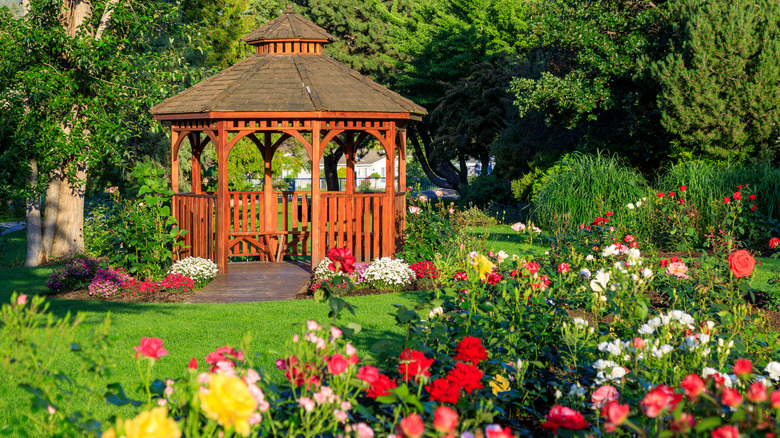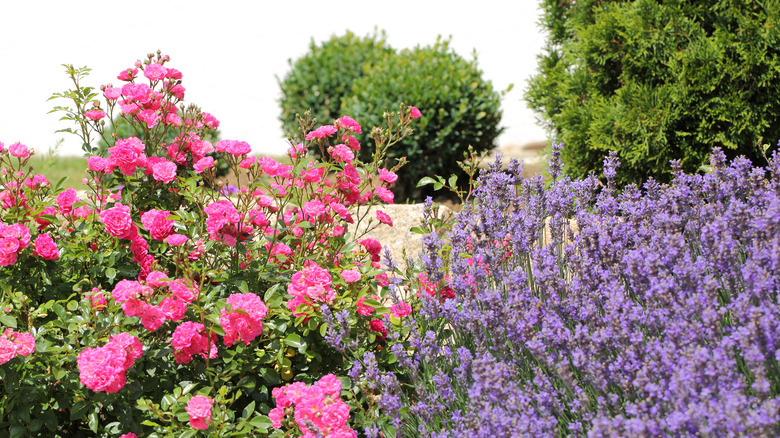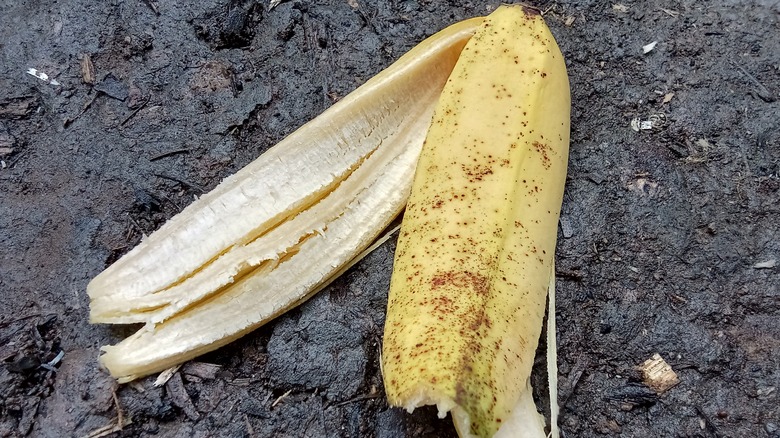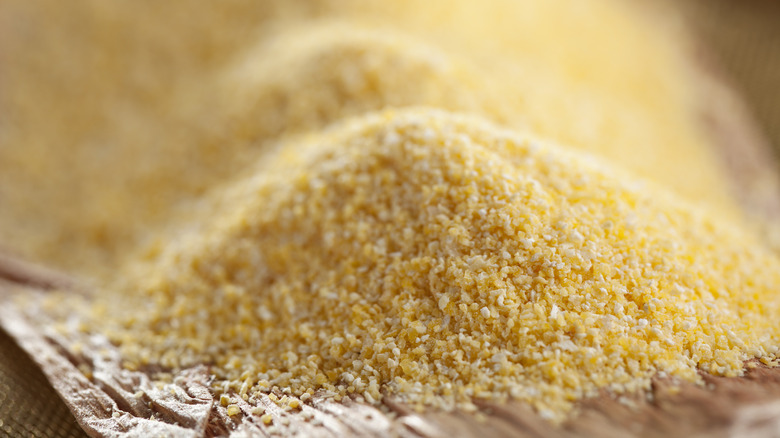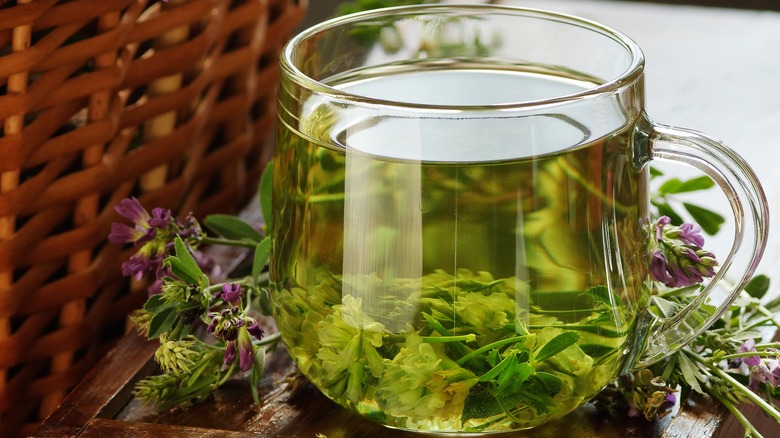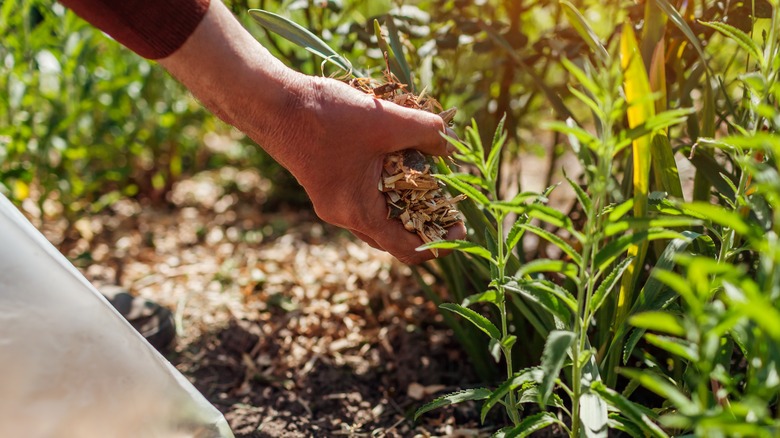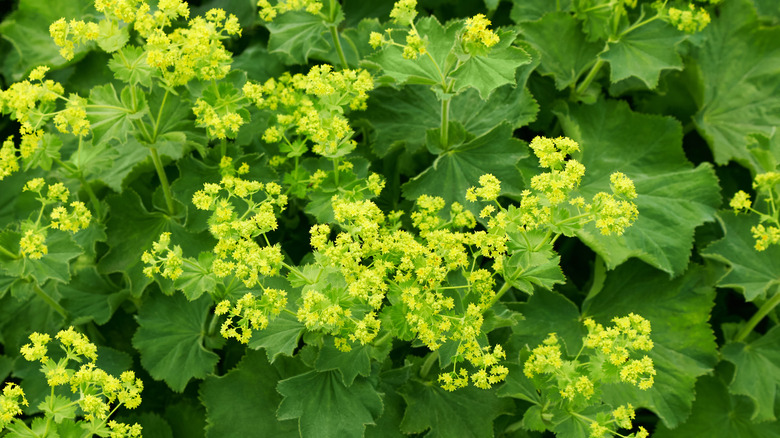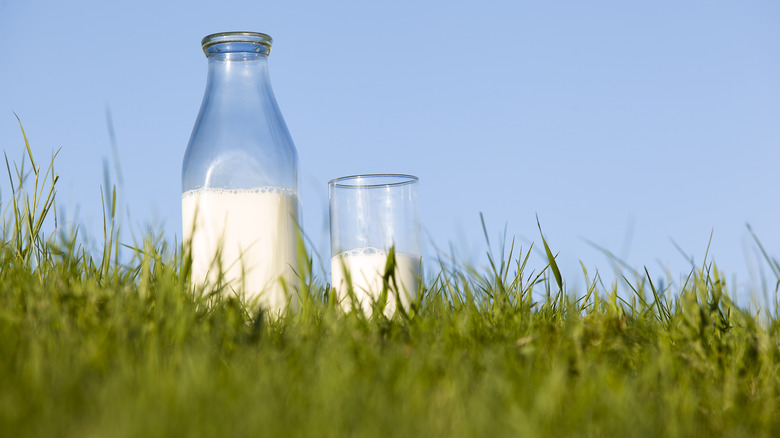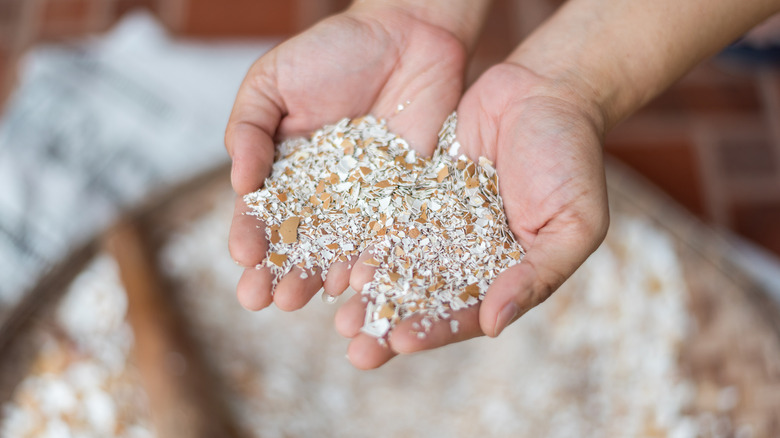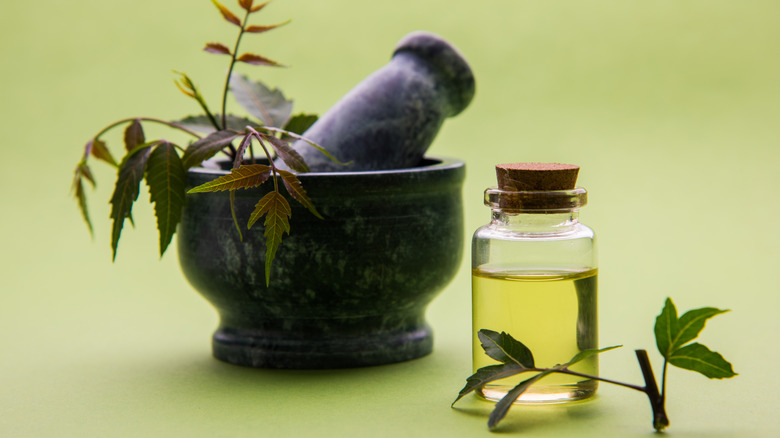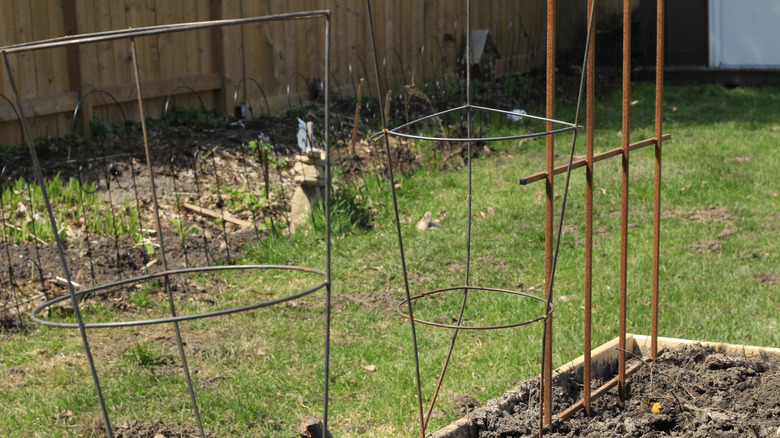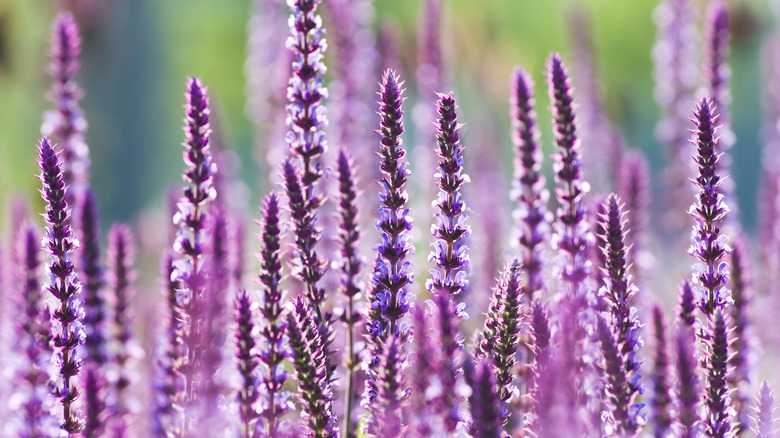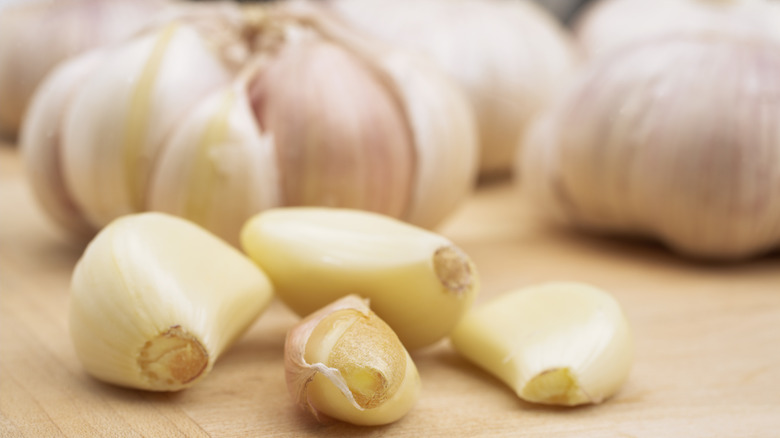Clever Tricks That Will Help Your Rose Garden Thrive
We may receive a commission on purchases made from links.
According to the National Garden Bureau, garden roses have remained popular since they were first grown for medicinal purposes back in the Middle Ages. Their showy blooms add color and beauty to any garden space, which has no doubt contributed to their high demand. Roses can, however, be a bit more demanding when it comes to their care. In order to see the flowers flourish, you'll need to implement a few clever tricks.
Once you start incorporating a few key strategies, you'll begin to see the roses respond with health and vigor. You'll find alfalfa tea helps to stimulate plant growth, while using lady's mantle as a ground cover keeps weeds at bay. Repurposing a tomato cage adds support for newly planted roses, as well as protection from cold temperatures. You can even take advantage of companion planting to ward off insects and plant pests. Combine these techniques with your roses' typical care requirements and you'll enjoy a garden that is both attractive and fragrant.
Repel aphids, deer, and rabbits using lavender as a companion plant
When it comes to plant pests, roses are susceptible to a few of the most common creatures. Not only do they draw the attention of aphids, but deer and rabbits also enjoy munching on rose plant parts for food. One way to combat these pests is to add lavender as a companion plant. Lavender enjoys similar growing conditions, and it is listed by experts as one of several deer and rabbit-resistant plants. Additionally, aphids don't like the scent of lavender, so planting this crop next to your roses will repel the unwanted insect.
Planting lavender next to roses isn't hard, as you've already got the well-draining soil and full sun requirements taken care of thanks to the roses. It's recommended that you prepare the soil for planting by working 1 inch of compost into the top 4 inches of earth. Incorporate new plants once all threats of frost have passed come spring. Since lavender can grow 2 feet tall and 2 feet wide, you'll want to space the plants every 24 inches. Although lavender requires extra water immediately after planting, watering once a week after they have become established and have presented flowers is all that is needed.
Warning: Lavender isn't the best choice for weed management, so you'll still need to incorporate other tips to keep pesky weeds at bay.
Add banana peels to provide the roses with extra nutrients
If you're ready to give your roses a boost of nutrients, start saving your banana peels. While the fruit casing contains sulfur, calcium, and magnesium, it is really rich in both phosphorus and potash. According to the American Rose Society, these two components aid in the growth of the roses' stems and produce flowers that are full and vibrant. Of course, repurposing the banana peels instead of tossing them in the trash offers the added benefit of caring for the environment.
There are two ways you can use banana peels to enrich the soil surrounding your roses. You can cut the peels up into smaller pieces and place them in a jar of water. After two weeks, pour the contents of the jar over the soil around the base of the roses. Another option is to dry the banana peels out and then crush them into a powder. Store the powder in an envelope until it's time to plant roses in the spring. Add the powder to the planting hole before filling it in. It's important to note that you should never use more than three banana peels per bush, as this could negatively affect the roses.
Use cornmeal to prevent black spot disease
Young roses are susceptible to black spot disease, which is caused by the fungus Diplocarpon rosae. The disease is identifiable by its black spots, which sometimes are accompanied by a yellow ring around them. The spots can be found on both the leaves and the stem. If left unchecked, new spores can germinate in as little as two weeks. Surprisingly, you can actually prevent this disease using cornmeal. Studies showed cornmeal was just as effective against fungal disease as chemical fungicides.
Since cornmeal is a pantry staple, you'll save both time and money when you use it as a black spot preventative. If you don't have any on hand, you'll find a 5-pound bag is available at most Walmart stores for around $22. To apply the cornmeal, you simply scatter it around the base of your roses, rake it into the soil, and then water over it. Repeat the process every month during the growing season to keep black spot at bay.
Warning: If you live in an area where fire ants, squirrels, and deer are a problem, you won't want to simply scatter the cornmeal, as it will attract these pests to your garden.
Stimulate plant growth with alfalfa tea
While you may be familiar with alfalfa as a weed-controlling garden mulch, you may not be aware that it can also be used as a plant growth stimulant. Alfalfa contains important nutrients, such as nitrogen, magnesium, and phosphorus, as well as the growth stimulant triacontanol that will help your roses thrive. While there are several ways to provide your roses with the benefits alfalfa has to offer, creating a tea is an excellent way to provide the bush with a nutritious drink.
To create the tea, you'll need to fill a 30-gallon trash can almost to the top with water. Add 10 cups of alfalfa (pellets and alfalfa meal both work) to the water and give it a stir. Set the trash can in the sun for a total of five days, being sure to stir the tea each day. As the roses are growing, feed each bush a gallon of alfalfa tea every six weeks or so. If the tea is hot when you retrieve it from the can, add some cold water before pouring it around your rose bushes. You don't want to burn the plant. On another note, since the alfalfa tea can emit an unpleasant odor, you may wish to set the trash can away from any outdoor porch or patio spaces.
Switch to a coarse mulch to prevent foliage disease
Rose bushes benefit from mulch, as it does an excellent job of suppressing weeds and keeping the soil moist. Choosing a coarse mulch instead of a fine mulch adds another layer of protection to keep the roses healthy and free of foliage disease. The coarse mulch works by hindering water from bouncing back up onto the roses' leaves. Water-logged leaves make the plant susceptible to fungal diseases, so taking steps to keep the leaves dry is the best prevention method.
There are several different coarse mulches to choose from. You can go with sawdust, straw, pine needles, shredded leaves, or cedar. Whichever you decide to go with, apply the mulch at a thickness of 2 to 3 inches. Even grass clippings work if that's all you have available. Surround the base of the rose bush, but don't set the mulch directly up against the stem of the plant. A distance of 2 inches is best, otherwise you make the bush more susceptible to rose pests and diseases. Water over the mulch and you're all done!
Plant lady's mantle as a ground cover to keep weeds in check
Another companion plant that helps rose gardens thrive is lady's mantle. Roses flourish when they are not competing with weeds for nutrients, and lady's mantle suppresses those weeds when grown as a cover crop. The plants' yellow-green flowers are arranged in clusters and are quite fetching when planted next to darker-colored roses. Another benefit to using lady's mantle as a cover crop is that it draws pollinators, such as butterflies, to the garden.
Lady's mantle is actually a member of the rose family, so you'll find it enjoys a lot of similar growing requirements, such as well-draining soil that is a bit moist and full sun to partial shade. It grows about 12 inches high and 12 inches wide and can be planted in October for a May bloom. Make sure you space seeds 18 inches apart when planting. While the crop is virtually maintenance-free, it is considered invasive in the Pacific Northwest, so you'll need to implement control measures if you use lady's mantle in this area.
Use milk to prevent powdery mildew
While many home remedies for growing roses have been debunked, there is one that stands the test of time – milk! Milk actually works to prevent fungal diseases, like powdery mildew. It won't cure the disease, but it has been shown to prevent it. Michigan Live even states that all types of cow's milk are effective, including 2 percent, skim, and even powdered milk. So what is it exactly about milk that prevents fungal infections? According to a study published in the National Library of Medicine, milk contains a protein called lactoferrin that works to defend plants against fungal attacks.
To use milk to keep your roses healthy, you'll want to mix it with water. Fill a spray bottle with half water and half milk. If you're using powdered milk, you'll need to follow the instructions on the product label to first turn it into liquid milk. Spray the milk mixture on the leaves of your roses once a week during the growing season. Let the solution remain for 24 hours before rinsing the leaves clean.
Increase calcium levels with crushed eggshells
Calcium is an important nutrient for roses, as it keeps them looking their best. Without it, roses begin to wither, weaken, and become discolored, leaving your garden looking lackluster and unhealthy. One way to add more calcium to the soil surrounding your roses is to use crushed eggshells. Unfortunately, simply tossing the eggshells into the soil won't work. You need to crush them for the calcium carbonate to be released in a way that can be absorbed by your prized flowers.
To prepare your eggshells for the garden, rinse them off and set them on a few sheets of paper towel or newspaper to dry. Once they have dried, you need to crush them into powder form. There are several ways to do this with the easiest being a coffee bean grinder. You can also use a blender or crush them by hand by placing them in a bag and hitting the bag with a rubber mallet. Sprinkle the powder of three crushed eggshells around each of your rose bushes. Repeat every two weeks during the growing season.
Tip: If you don't want to use eggshells, you can use bone meal for added calcium instead.
Eliminate insect pests naturally with neem oil
Roses are not immune to pests, so in order for your garden to thrive, you need to eliminate the insects as soon as they are spotted. The most common pests that frequent rose bushes are whiteflies, aphids, and thrips. Whiteflies and aphids are known for sucking the sap out of plant stems, while thrips injure flower petals by sucking out cell tissue. Whiteflies and aphids also leave behind a sticky substance that makes roses more susceptible to the black sooty mold fungus. If you spot any of these insects on your roses, grab neem oil, as it is a natural pesticide that is extremely effective. It contains the ingredient azadirachtin, which interferes with the insect's ability to grow and reproduce.
Neem oil can be purchased at any garden or home improvement store. You can also order pure neem oil on Amazon for just under $20. You'll need to follow the directions on the neem oil bottle for mixing and application. Most require you to combine the oil with water in a spray bottle, or garden sprayer if dealing with a larger crop. Some also call for adding a few drops of liquid dish soap. Once combined, spray your plants. Weekly repeated use may be needed to gain full control of an infestation. Check your roses every seven days and reapply if any pests are spotted.
Provide support and protection using a tomato cage
Oftentimes, newly planted roses require a bit of support to grow and thrive. One way to provide that support is to repurpose a tomato cage that you're no longer using. Depending on the climate where you live, the tomato cage can also be utilized to protect rose bushes from cold temperatures. If you don't already own a set of tomato cages, you can get high-quality heavy duty 2-pack at your local Home Depot for around $33.
After planting your young roses, slide the tomato cage over top. Push down so that the legs enter the soil to act as an anchor. Adjust the leaves if they are being bent by the side wires and then tie the plant to the cage using garden twine. Once temperatures begin to dip, add fallen leaves or your preferred mulch inside the cage. This will provide the rose bush with insulation to keep it warm. You can also drape a sheet over the cage to protect the plant from the cold and stormy conditions.
Plant salvia to attract pollinators
Roses won't produce fruit or seeds without being pollinated, so if you want your plant to produce rose hips for year-round interest, this step is a must. Adding a companion plant to your rose garden that is a known attractant of pollinators is an excellent way to ensure your bushes thrive throughout the growing season. Salvia, also commonly referred to as ornamental sage, is compatible with roses and works well to draw hummingbirds and butterflies to the garden to pollinate the roses. The plant's flowers are an attractive purple and have a strong sweet scent that insects just love.
Once soil temperatures rise above 55 degrees Fahrenheit, salvia can be planted. Like roses, they require well-draining soil and plenty of sun. Since salvia can grow up to 6 feet tall, you'll want to space the plants out at a distance of three feet. While it's best to apply an all-purpose fertilizer when planting salvia, you won't need to use it again after that. The plant is virtually maintenance-free and has no big issues with pests or diseases. Simply water the salvia anytime the top two inches of soil becomes dry and you're good to go.
Improve the scent of the roses using garlic
Thriving roses don't just look good, they smell good too. One way to improve the scent of the roses in your garden is to plant garlic nearby. The Herb Society of America reveals that garlic planted near roses has been proven to increase the aroma of the beloved flowers. Since it isn't considered invasive, you won't have to worry about it overtaking the garden. If, however, you find the garlic plants are prolific, you can simply harvest some of the herb and use it in the kitchen to flavor your favorite meals.
Garlic is similar to roses in that it prefers moist, well-draining soil. Before you plant the herb, it is essential that you thoroughly weed the area and till the soil. Work a little urea into the soil to increase fertility and provide the garlic with the added nitrogen they require. Bulbs can be planted in the fall, as long as you wait until after the first frost. During the growing season, make sure you water garlic at a rate of one inch per week. While garlic is susceptible to onion maggot infestations, the crop's biggest concern is weeds. You can keep an eye out and remove them as you see them or add a mulch that offers weed suppression.

